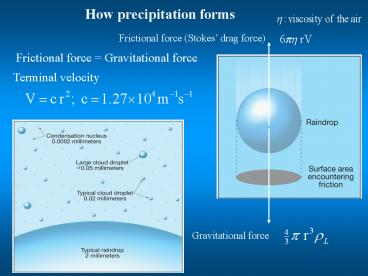How precipitation forms PowerPoint PPT Presentation
1 / 12
Title: How precipitation forms
1
How precipitation forms
Frictional force (Stokes drag force)
Frictional force Gravitational force
Terminal velocity
Gravitational force
2
Condensation nucleus
Typical cloud droplet
Large cloud droplet
Rain droplet
3
Bergeron Process
When vapor condenses into water, the molecules
spend part of their time as members of clusters
which are continually forming and breaking up. To
make the final transition from a liquid to the
lattice structure of ice, however, some kind of
foreign particle--an ice nucleus--is needed to
initiate freezing. Until this nucleus forms,
liquid water can exist far below the freezing
point. Such water is called supercooled. In
fact, pure water droplets can remain in liquid
form down to temperatures near -40F.
Ice crystal molecules more organized, difficult
to escape
Isupercooled water droplet molecules less
organized, easy to escape
The saturated vapor pressure above ice crystals
is some what lower than above supercooled water
droplets. Es lt E
condensate
evaporate
Mixed phase clouds
4
1. Supercooled water droplets are readily to
freeze if they impact an object. 2. Enlarged
crystals are easy to break up into fragments
serving as freezing nuclei.
5
Precipitation from warm clouds
Collision-Coalescence Process
a.Collision -Larger drops fall faster than
smaller drops, so as the drops fall, the larger
drops overtake the smaller drops to form larger
drops until rain drops are formed.
-Cloud droplets collide and are
either 1.Collected on the larger drop's forward
edge as it falls. 2.Captured in the wake of a
larger drop that is falling.
-In a cloud with cloud droplets that are tiny and
uniform in size -The droplets fall at a similar
speed and do not Collide. -The droplets have a
strong surface tension and never combine even if
they collide.
6
b.Coalescence -The merging or "sticking together"
of cloud droplets as they collide.
Droplets may 1.Stick together/Merge
2.Bounce off one another
3. Airstream repelling
4. Coalescence is enhanced when droplets have
opposite electrical charges.
The collision-coalescence mechanism is more
efficient in environments where large cloud
droplets are plentiful.
Where? tropics
The Bergeron process is more efficient for mixed
clouds with plentiful ice crystals and
supercooled water droplets.
Where? Mid-latitudes
7
Forms of precipitation
8
(No Transcript)
9
(No Transcript)
10
Hail
Heaviest hailstone fell in Coffeeville, Kansas
on September3, 1970 and weighed 1.67 lbs.
Some hails clear show ring structure.
Inside of a thunderstorm are strong updrafts of
warm air and downdrafts of cold air.
If a water droplet will freeze if it is picked up
by the updrafts well above the freezing level.
As the frozen droplet begins to fall...carried
by cold downdrafts...it may thaw as it moves
into warmer air.
The half-frozen droplet may get picked up again
by another updraft...carrying it back into very
cold air and re-freezing it.
Finally...the frozen water droplet...with many
layers of ice (like rings)...falls to the ground.
11
Precipitation measurement
Rain gauge
Measuring snowfall depth and water equivalent
Rain gauge with metal slats to
minimize under-catch in windy conditions
Measurement error
Weather radar
12
Weather modification
The first employs energy to forcefully alter the
weather
(e.g., disperse fog at airports).
The second involves modifying land and water
surface to change their natural
interaction with the lower atmosphere (e.g.,
greenhouse)
The third involves triggering, intensifying, or
redirecting atmospheric process
(e.g., cloud seeding)

